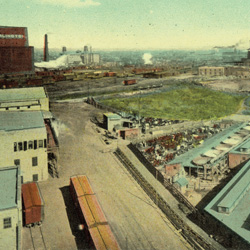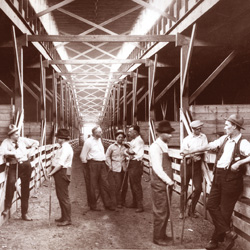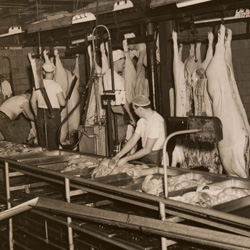“…there is no livelier or busier place in central Illinois than at the Union Stock Yards of Peoria” —History of Peoria County, Illinois, 1880.
The development of the railroad in the post-Civil War era—from roughly 30,000 miles of track in 1865 to nearly 130,000 miles of track 30 years later—facilitated the growth of the livestock industry nationwide, as railroads connected livestock producers to a growing consumer market. Peoria’s central location in the country, riverfront advantage and booming distilleries fueled the city’s hog and cattle stockyards.
The “stockyards” was a broad term encompassing a number of entities, including the “livestock hotel”—the actual facility to hold, feed and water the animals—and its workers, the meat-packing plants and their representatives, offices for livestock dealers, press, loan companies, veterinarians, inspectors and other government officials, as well as local hangouts, including diners and “watering holes” for the humans. Milburn Cross, general manager of the Peoria Union Stock Yards, said the stockyards were “sort of like a combined hotel, stock market and fruit and vegetable market all rolled into one.”
 In most cities, the stockyards covered a large geographical area. Chicago, for example, was home to the largest livestock center in the country, the Chicago Union Stock Yards and Transit Company, which encompassed 345 acres south of the city. The name represented the union of several disparate companies into one business enterprise located near the railroad terminus. In Chicago, as in many places, ownership of the stockyards overlapped with the railroad and meatpacking companies. By investing in both, meatpacking companies often controlled the transportation and housing of the livestock they planned to process. The birth of the stockyards industry in Peoria, however, developed quite differently.
In most cities, the stockyards covered a large geographical area. Chicago, for example, was home to the largest livestock center in the country, the Chicago Union Stock Yards and Transit Company, which encompassed 345 acres south of the city. The name represented the union of several disparate companies into one business enterprise located near the railroad terminus. In Chicago, as in many places, ownership of the stockyards overlapped with the railroad and meatpacking companies. By investing in both, meatpacking companies often controlled the transportation and housing of the livestock they planned to process. The birth of the stockyards industry in Peoria, however, developed quite differently.
From Slop to Table
In Peoria, Thomas Neill of the Wickert and Neill distillery established the Peoria Union Stock Yards in 1874. Neill’s grand idea was to feed animals the grain mash, or slop, a byproduct of the distilleries. According to Bryan J. Ogg’s Peoria Spirits: The Story of Peoria’s Brewing and Distilling Industries, “By 1865, Peoria was well on her way to becoming the ‘Whiskey Capital of the World’”—a title which would also secure the city’s success in livestock. The connection between the two industries was evident in the 1887 establishment of The Distillers’ and Cattlefeeders’ Trust (later re-named the Distilling and Cattle Feeding Company to avoid the stigma of identifying itself as a trust), which dominated business until it was dissolved by the Supreme Court in 1895.
The pivotal role of the distillery business in Peoria had a sizable impact on the success of the stockyards. At their peak, writes local historian Jerry Klein, the distilleries could feed 28,000 animals. But this arrangement was not without its problems. In 1904 at the Corning & Co. Distillery, fermented whiskey mash caught fire as it made its way down the feed troughs, killing several thousand cattle. This was one of many distillery-stockyard fire traumas in Peoria.
But the beneficial impact of the distilleries expanded beyond the city, as “Illinois fed over one half of all distillery-fed cattle in the U.S., and Peoria fed more than half of the total for the state,” writes Ogg. The Peoria Union Stockyards, located at the foot of South Street, became one of the largest stockyards in the country. According to History of Peoria County Illinois: Illustrated, 1880:
“The Stock Yards comprise 30 to 35 acres of land enclosed by a high board fence, laid off with planked and graded streets and alleys, and subdivided into a great number of yards and pens. Some of these pens are covered and some open, but all are provided with troughs, into which a constant stream of the purest water flows from the 840-feet-deep artesian well on the grounds, through a perfect network of underlying water pipes.
A railroad track runs the entire length of the Stock Yards, along side of which are platforms and chutes for unloading and loading. Here a train of 20 cars of hogs can easily discharge its entire freight in a very few minutes.”
 By Hoof, Wagon, Barge…
By Hoof, Wagon, Barge…
Livestock did not always come by rail, however, as the earliest producers brought their animals to town “on the hoof,” depending on the distance and condition of the roads. Farmers were also known to load animals on their wagons—or bobsleds in the winter—for the longer rides to town. They might have stayed overnight at Noah and John’s Hotel—the old Stockyards hotel—if their wagons got stuck in the mud. Packets or barges picked up livestock at river ports like Havana, Bath or Beardstown.
“Sunday and Thursday were boat nights,” the Peoria Journal Star explained on February 7, 1955. “All the hired men representing the various commission firms would be on hand with lanterns swinging to set up the fences from the boats across the railroad tracks to the alleys…the air would ring with shouts and shrill whistles as the hogs were driven in.”
Eventually, these modes of transport were replaced by the railroad, and later, by the trucking industry. But however they arrived, the volume of business was staggering from its earliest years. In 1878, the value of cattle, hogs and sheep received at the stockyards was $4.5 million. In comparison, distilling and grain values for 1878 were $8.5 million and $4.5 million respectively, according to History of Peoria County, Illinois: Illustrated, 1880.
 A Growing Enterprise
A Growing Enterprise
The stockyards changed hands several times in the late 19th century. In 1905, H.F. Embry, Talton Embry and B.E. Gregory took over operations, renaming it the Peoria Union Stock Yards Company. By 1923, Embry and his partners purchased the company outright and conducted $25 million worth of business that year. Improvements and expansions occurred over the years, while operations continued on a 24/7 schedule. By 1928, Peoria was the third largest truck market in the United States, and by 1935, 97 percent of hog receipts were transported by truck.
A growing enterprise, the Journal Star reported on January 19, 1956 that, between 1890 and 1930, it was estimated that the stockyards business amounted to $600 million. A close-knit industry, the business of the stockyards was conducted on the “code of honor,” verbal agreements between livestock traders, also known as the stockman’s code. There was regulation of the industry, however, after Congress passed the Packers and Stockyards Act in 1921. According to the Act, the stockyard companies—many owned or controlled by meat-packing interests—could no longer buy or sell the livestock they received, contributing to the increase of direct (i.e., from the farmer) buying, which would later contribute to the decline of the stockyards. Since then, the Packers and Stockyards division of the U.S. Department of Agriculture has overseen the rates, charges and rules of the large, terminal markets.
Breaking Records
In the mid-1930s, an estimated 250 people were employed by the stockyards, while over 700 worked in the packing houses, together employing more than 1,000 people in the livestock market in downtown Peoria. During this time, expansion was largely due to Armour & Co. purchasing the Wilson Provision plant, as well as the emerging sheep market—from 22,000 sheep receipts in 1933 to 79,000 in 1935. (Interestingly, most of the lamb ended up on tables in New York and New England—a staple in the East, but a low-demand item here at home).
A huge increase in business occurred on November 28, 1938, as a result of a stockyard strike in Chicago. Peoria received the largest receipt of hogs in its history—over 11,400—on one day. They arrived via farmers from 20 central and west-central Illinois counties, as well as from eastern Iowa and Missouri. The Journal Star writes that a point of pride for Peorians is that all but 150 hogs had been sold by evening that day.
Another jump in business occurred during World War II. In 1942, over one million head were handled in Peoria, providing food for central Illinois, Eastern markets, U.S. troops and the United Nations’ lend-lease requirements. If all the livestock handled in 1942 was arranged in a single-file line, it would have extended 1,000 miles from Peoria to Grand Junction, Colorado.
 New Tastes, Better Cuts
New Tastes, Better Cuts
The post-war years were prosperous for consumers, who had more spending power and were demanding better cuts of meat. The employment of new breeding techniques to produce leaner hogs was discussed at the Peoria Producers Commission meeting at the Hotel Pere Marquette, where President Maurice Holmes noted in 1956 “that one of the health hazards the American people face today stems from too much fat in their diets.”
Post-war prosperity resulted in expansion of the stockyards, as well. A new, two-story brick building—replacing the exchange building of 1886—was constructed in 1954 at a cost of $300,000. Buried in the cornerstone was a metal box containing “a picture of the old Stock Yards hotel building, a history of the exchange, a penny, a nickel, a quarter and a half-dollar coined in 1954, and other objects symbolic of the occasion,” including newspapers from the day, reported the Journal Star. To make way for the new headquarters, the 1875 Stock Yards Hotel was torn down a year later.
The building boom followed prosperous years when, for example, over $77 million in livestock was sold in 1952, and Peoria was rated the eighth largest hog market in the country. By 1959, that figure was $80 million, reported Jerry Klein in the Journal Star, with stockyard capacity of “12,000 head at one time, or roughly a small city of bleats, moos and oinks.”
Fewer animal noises would be heard over the years as the large packing plants began to close. The closing of the Armour Co. in 1967 had a significant impact on the Peoria stockyards, as they represented a large portion of its annual receipts. But when the Chicago Union Stockyards closed in 1971, Peoria initially benefited from some of its business, becoming sixth in hog receipts nationwide. A 75,000-square-foot covered addition with paved pens and alleys was added to accommodate the uptick in business. Indeed, in 1975, total receipts at the stockyards were $221 million. The following year, receipts of $232 million were recorded, although most of the 1.3 million animals sold were shipped to be processed elsewhere, as the Calihan Co., the last major packing plant in town, was unable to process the entire load.
Waning Sales, Squeals
In the U.S., “one-third fewer meat-packing and processing facilities operated in 1983 than had existed in 1945,” Pate writes. Companies like IBP, established in 1960, built modern packing plants in rural areas and shipped “chilled packaged meat ready to place on a supermarket meat counter,” she continues. By the late 1970s, “90 percent of the business [was] handled out in the country, in an uncompetitive market,” the Journal Star wrote, “simply because it [was] so handy.” And by the 1980s, about a third of the major stockyards in the country had closed.
Terry Barnstable, current yard manager of Peoria Livestock, Inc., has been in the field since the early ‘70s. During a recent tour of the stockyards, he said it was a “booming place” between 1971 and 1985, when the guys in the yard worked from 4:30am through mid-afternoon, often without a break. But today, receipts are far below the peak of the mid-‘80s, although several hundred hogs move through the yards daily on their way to packing plants.
“From Portland to Peoria, all the major livestock markets faced the same problems: declining use of railcars, increased truck traffic, outdated packing plants at the yards, and the new feedlot phenomenon that drew meatpacker buyers to the country and enlarged country auctions,” Pate explains.
The declining trend is evident by the decrease in hog receipts in Peoria over the second half of the 20th century: from 1.1 million in 1952 to just over 215,000 in 2001. In 1992, Foster Embry, president of the Peoria Union Stock Yards and grandson of the company’s founder, and his family sold the business to a group of owners, including Ron Jenkins, who is the current owner today.
At the beginning of the 21st century, only a handful of the once-thriving stockyard businesses survive, and Peoria—one of the oldest in the country—is included in this distinguished class, despite significant transformation from its former heyday. iBi
Deborah Dougherty is a professor of history and political science at Illinois Central College and a trustee for the Peoria Historical Society Board of Directors.


